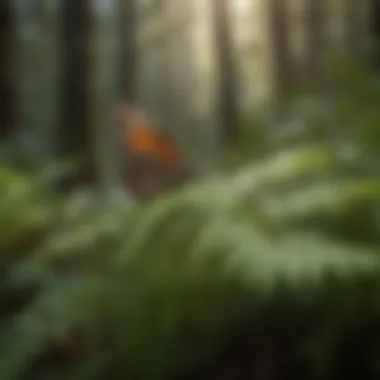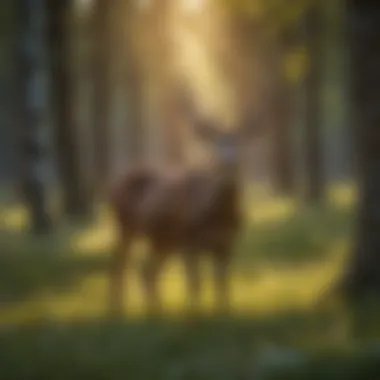Unveiling the Mesmerizing World of a Forest Meadow: A Biodiversity Showcase


Evergreen Trees Species
Evergreen trees play a vital role in the ecosystem of a forest meadow, providing stability, shelter, and sustenance for a myriad of species. As we immerse ourselves in the enchanting world of a forest meadow, it is essential to understand the diverse types of evergreen trees that grace American forests. From towering pines to majestic firs, each species contributes uniquely to the rich tapestry of this biodiverse landscape. Exploring the characteristics and habitats of these evergreen giants offers insight into the complexity and beauty of nature at play.
Ecological Significance
Diving deeper into the mesmerizing realm of a forest meadow, we uncover the ecological significance of evergreen trees. These majestic guardians of the forest not only provide oxygen and shelter but also contribute to the intricate web of life through their ability to sequester carbon dioxide. Understanding the crucial role that evergreens play in maintaining ecological balance sheds light on the harmonious relationship between flora, fauna, and the environment. Each tree stands as a testament to resilience and interconnectedness within this captivating ecosystem.
Conservation Practices
In the quest to safeguard the irreplaceable treasures of evergreen tree species, conservation practices are paramount. From designated protected areas to sustainable forestry management, initiatives are in place to preserve the biodiversity and natural heritage of forest meadows. Highlighting the importance of implementing conservation strategies, including reforestation efforts and land preservation, underscores the collective commitment to ensuring the longevity and vitality of these iconic trees.
Forest Management Techniques
As stewards of the land, effective forest management techniques are crucial in maintaining the delicate balance of a forest meadow. Wildlife habitat preservation strategies focus on creating sanctuaries for diverse species to thrive, interconnected by flourishing ecosystems. Sustainable logging practices adhere to responsible forestry operations, ensuring that timber harvesting methods prioritize long-term environmental sustainability. Fire prevention measures and ecosystem restoration initiatives further underscore the dedication to nurturing and protecting the natural sanctuaries that evergreen forests provide.
Climate Change Impact on Evergreen Forests
The enduring resilience of evergreen forests faces new challenges in the era of climate change. These majestic woodlands play a pivotal role in carbon sequestration, serving as vital carbon sinks in combating global warming. However, the shifting weather patterns and altered biodiversity within evergreen forests reveal the profound effects of climate change on these ecosystems. Exploring the localized impacts on communities and ecosystems underscores the urgency of implementing adaptive measures to mitigate the consequences of environmental transformation.
Management and Preservation of Evergreen Forests
Reflecting on the historical context of American evergreen forests offers insight into the deep-rooted significance of these natural wonders and the enduring legacy of ancient forestry practices. Current research findings inform conservation efforts and sustainable management strategies, showcasing a holistic approach to preserving the diverse landscapes of evergreen forests. By highlighting successful conservation efforts and ongoing initiatives, the dedication to protecting and nurturing these pristine environments becomes a beacon of hope for future generations.
Outdoor Activities in Evergreen Forests
For outdoor enthusiasts and nature lovers, evergreen forests offer a playground of exploration and wonder. Serene hiking trails meander through lush canopies, providing a gateway to untouched wilderness areas waiting to be discovered. Camping destinations beckon adventure seekers to immerse themselves in the tranquil embrace of nature, surrounded by towering trees and clear mountain air. Photography enthusiasts find endless opportunities to capture the splendor of evergreen landscapes, while birdwatching enthusiasts marvel at the diverse avian species that call these forests home. Engaging with nature in evergreen forests evokes a sense of wonder and appreciation for the untamed beauty that thrives within this enchanting ecosystem.
Introducing the Forest Meadow
A forest meadow stands as a majestic tapestry of biodiversity, enchanting the beholder with its intricate ecological web. In this article, we delve into the heart of the forest meadow, unraveling its unique elements and significance. By exploring the diversity of plant and animal life within this ecosystem, we aim to provide forestry professionals and academics with a comprehensive understanding of its ecological complexities. This section serves as the gateway to a journey through the serene beauty and hidden wonders held within the forest meadow.
Defining a Forest Meadow


Characteristics of a Forest Meadow
The characteristics of a forest meadow showcase a blend of thriving plant species and delicate ecological balances. From vibrant wildflowers to lush grasses, these meadows create a haven for a myriad of flora and fauna. Their open spaces allow sunlight to reach the forest floor, nurturing the growth of unique plant communities. The diversity of species present underscores the resilience and adaptability found within forest meadows, making them essential landscapes for biodiversity conservation efforts.
Ecological Importance
The ecological importance of forest meadows lies in their role as crucial habitats for a variety of species. Serving as vital foraging and nesting grounds for wildlife, these meadows play a key role in supporting ecosystem health. Additionally, they contribute to carbon sequestration and climate regulation, making their preservation imperative for environmental sustainability. Despite facing conservation challenges, the ecological significance of forest meadows cannot be understated, making them invaluable components of our natural world.
Location and Habitat
Ecosystem Diversity
The location and habitat of a forest meadow exemplify the concept of ecosystem diversity at its finest. These meadows integrate seamlessly with surrounding forested areas, creating transition zones that host a plethora of plant and animal life. The mix of open spaces and tree cover fosters a rich array of habitats, attracting a diverse range of species. This diversity not only supports various ecological interactions but also contributes to the overall resilience of the ecosystem.
Plant Adaptations
Plant adaptations within forest meadows showcase nature's ingenuity in thriving under diverse conditions. From specialized seed dispersal mechanisms to unique survival strategies, plant species in these habitats have evolved to make the most of available resources. The ability to adapt to changing environmental conditions is a hallmark of plant communities in forest meadows, illustrating their capacity to endure and flourish within dynamic ecosystems.
Flora of the Forest Meadow
The flora of a forest meadow plays a pivotal role in enriching the biodiversity and ecological balance of this unique ecosystem. In this article, we delve deep into understanding the intricate relationship between native plant species and their surroundings, shedding light on their significant contributions. By exploring the specific elements, benefits, and considerations regarding the flora of the forest meadow, we aim to provide forestry professionals and academics with a comprehensive guide to appreciate the true essence of this enchanting environment.
Native Plant Species
Flowering Plants
Within the forest meadow, flowering plants emerge as vibrant ambassadors of beauty and functionality. These botanical marvels not only enhance the visual appeal of the landscape but also serve as essential pollinator attractants, promoting ecological interactions. Their key characteristic lies in the production of colorful blooms, each uniquely adapted to attract specific pollinators, ensuring successful reproduction. The presence of flowering plants in the forest meadow signifies a healthy ecosystem, offering nectar and pollen as vital food sources for various insects and birds. Despite their sensitivity to environmental changes, flowering plants stand out as a popular choice for conservation efforts, showcasing the resilience and adaptability of nature within the context of this article.
Grasses and Ferns
In the intricate tapestry of the forest meadow, grasses and ferns weave a foundation of stability and diversity. These plant species are characterized by their efficient reproduction mechanisms and capacity to thrive in different environmental conditions. Grasses provide essential ground cover, preventing soil erosion and offering habitats for small mammals and insects. On the other hand, ferns with their unique reproductive structures contribute to the overall biodiversity of the forest meadow, creating microhabitats for specialized flora and fauna. While both grasses and ferns exhibit distinct advantages, such as their ability to adapt to varying light conditions and soil types, they also face challenges in competing for resources within this ecosystem, underscoring the delicate balance required for their survival.
Specialized Adaptations
Seed Dispersal Mechanisms


Survival Strategies
Role in Biodiversity
Supporting Wildlife
Interconnected Ecosystem
Fauna in the Forest Meadow
In the riveting exploration of the forest meadow, the section on Fauna serves as a vital component, shedding light on the diverse array of animal life inhabiting this enchanting ecosystem. Delving into the Fauna of the forest meadow allows us to unravel the interconnectedness between various species and their role in maintaining the delicate balance of nature. Understanding the Fauna in a forest meadow is crucial for comprehending the intricate web of life that thrives in this captivating environment.
Mammals and Insects
Deer and Rabbits
The presence of Deer and Rabbits in the forest meadow is of significant importance to the overall ecosystem. Deer are known for their browsing behavior, shaping the vegetation structure and influencing plant diversity. On the other hand, Rabbits play a crucial role in nutrient cycling through their feeding habits. Their unique ability to reproduce rapidly contributes to the ecosystem's dynamism, albeit sometimes leading to overgrazing challenges. Despite potential drawbacks, Deer and Rabbits are integral to the ecosystem's functioning, illustrating adaptability and resilience in the face of changing environmental conditions.
Pollinators
Pollinators, such as bees, butterflies, and birds, play a pivotal role in the reproductive success of flowering plants within the forest meadow. Their vital function in transferring pollen between flowers ensures genetic diversity and seed production, sustaining plant populations and supporting overall ecosystem health. Pollinators enhance biodiversity and foster resilience against environmental stressors, portraying a symbiotic relationship with the floral community within the forest meadow.
Avian Residents
Songbirds
Songbirds, with their melodious tunes and vibrant plumage, contribute to the tapestry of the forest meadow's auditory and visual splendor. These avian residents aid in seed dispersal and insect control, regulating populations of potential pests. Their presence signifies a healthy ecosystem, where biodiversity thrives, and ecological functions are maintained harmoniously.
Birds of Prey
Birds of Prey, including majestic eagles and falcons, embody the grace and power of nature within the forest meadow. As top predators, they play a critical role in controlling herbivore populations, thus impacting vegetation dynamics. Birds of Prey exemplify the concept of ecological balance, showcasing nature's ability to self-regulate and maintain equilibrium within the intricate web of life.
Predator-Prey Dynamics


Food Chains
Food Chains delineate the flow of energy within the forest meadow, showcasing the interconnected relationships between predators and prey. Through the consumption of lower trophic levels, predators sustain their energy needs, contributing to the regulation of ecosystem populations and biodiversity. Understanding Food Chains is fundamental to grasping the complexity of the forest meadow's dynamics and the resilience demonstrated through interdependent species interactions.
Ecosystem Balance
Ecosystem Balance epitomizes the harmonious coexistence of various fauna species within the forest meadow, reflecting a state of equilibrium where ecological functions operate seamlessly. Maintaining Ecosystem Balance is essential for sustaining biodiversity, preserving habitat integrity, and ensuring the resilience of the entire ecosystem against external pressures. The intricate interplay between different fauna components underscores the necessity of conservation efforts to safeguard the delicate balance of the forest meadow ecosystem.
Ecological Significance
Within the intricate tapestry of a forest meadow lies a profound significance that underscores the delicate balance of nature. This section delves deep into the core importance of ecological significance within the ecosystem, shedding light on its pivotal role in shaping biodiversity, ecosystem dynamics, and environmental resilience. By unraveling the layers of complexity inherent in ecological significance, readers gain a profound understanding of how this concept serves as the foundation for sustaining life within the forest meadow.
Biodiversity Hotspot
Keystone Species
Keystone species, the linchpins of ecological balance, play a vital role within the forest meadow ecosystem. These species exert disproportionate influence on the community structure, driving the health and diversity of the entire landscape. Exploring the nuanced interactions of keystone species reveals their irreplaceable function in maintaining biodiversity and ecosystem stability. By elucidating the key characteristics and unique features of keystone species, this section illuminates their pivotal contributions to the overarching goal of preserving the natural harmony of the forest meadow.
Habitat Preservation
Amidst the sprawling expanse of a forest meadow, habitat preservation emerges as a beacon of hope for safeguarding vulnerable species and sensitive ecosystems. This subsection shines a spotlight on the critical importance of preserving habitats within the forest meadow, illustrating how conservation efforts can nurture biodiversity and protect vital ecological niches. By highlighting the key characteristics and unique features of habitat preservation, readers gain insights into its multifaceted benefits and the intrinsic value it adds to the overarching mission of maintaining a thriving ecosystem.
Carbon Sequestration
Role in Climate Regulation
The phenomenon of carbon sequestration stands as a cornerstone in the fight against climate change, with its pivotal role in regulating atmospheric carbon levels. This segment dissects the intricate mechanisms through which carbon sequestration influences climate regulation within the forest meadow, emphasizing its significance in mitigating the impacts of global warming. By elucidating the key characteristics and benefits of carbon sequestration, readers uncover the importance of this process in fostering a sustainable environment for flora, fauna, and future generations.
Importance for the Environment
As a linchpin in the preservation of environmental stability, the importance of carbon sequestration reverberates throughout the forest meadow ecosystem. This section delves into the far-reaching implications of carbon sequestration for the environment, emphasizing its role in maintaining ecological balance and preventing biodiversity loss. By detailing the unique features and advantages of carbon sequestration, readers grasp the critical value it holds in safeguarding the fragile web of life woven within the forest meadow.
Conservation Challenges
Human Impact
Human activities exert a profound influence on the delicate equilibrium of the forest meadow, posing significant challenges to its long-term sustainability. This segment scrutinizes the various facets of human impact on the ecosystem, shedding light on the detrimental effects of human activities on biodiversity and habitat integrity. By unpacking the key characteristics and consequences of human impact, readers confront the pressing need for responsible environmental stewardship and the adoption of sustainable practices to mitigate the impending threats faced by the forest meadow.
Sustainable Practices
Amidst the mounting conservation challenges, sustainable practices emerge as beacons of hope, offering viable solutions to safeguard the forest meadow for future generations. This section underscores the importance of embracing sustainable practices in mitigating environmental degradation and promoting ecosystem resilience. By delineating the key characteristics and advantages of sustainable practices, readers are empowered to champion an ethos of sustainability and foster a harmonious coexistence between humanity and nature within the enchanting realm of the forest meadow.



